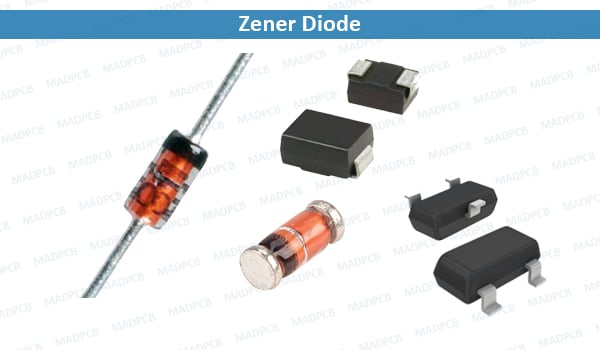What’s Zener Diode?
A Zener Diode is a special type of diode designed to reliably allow current to flow “backwards” when a certain set reverse voltage, known as the Zener Voltage, is reached. It is a silicon semiconductor device that permits current to flow in either a forward or reverse direction.
Zener diodes are manufactured with a great variety of Zener voltages and some are even variable. Some Zener diodes have a sharp, highly doped p-n junction with a low Zener Voltage, in which case the reverse conduction occurs due to electron quantum tunneling in the short space between p and n regions – this is known as the Zener Effect, after Clarence Zener. Diodes with a higher Zener voltage have a more gradual junction and their mode of operation also involves avalanche breakdown. Both breakdown types are present in Zener diodes with the Zener effect predominating at lower voltages and avalanche breakdown at higher voltages.
Zener diodes are widely in electronic equipment of all kinds and are one of the basic building blocks of electronic circuits. They are used to generate low-power stabilized supply rails from a higher voltage and to provide reference voltages for circuits, especially stabilized power supplies. They are also used to protect circuits from overvoltage, especially electrostatic discharge (ESD).
History
The device is named after American physicist Clarence Zener, who first described the Zener Effect in 1934 in his primarily theoretical studies of breakdown of electrical insulator properties. Later, his work led to the Bell Labs implementation of the effect in form of an electronic device, the Zener diode.
Operation
A conventional solid-state diode allows significant current if it is reverse-biased above its revers breakdown voltage. When the reverse bias breakdown voltage is exceeded, a conventional diode is subject to high current due to avalanche breakdown. Unless this current is limited by circuitry, the diode may be permanently damaged due to overheating. A Zener diode exhibits almost the same properties, except the device is specially designed so as to have a reduced breakdown voltage, the so-called Zener voltage. By contrast with the conventional device, a reverse-biased Zener diode exhibits a controlled breakdown and allows the current to keep the voltage across the Zener diode close to the Zener breakdown voltage. For example, a diode is therefore ideal for applications, such as he generation of a reference voltage (e.g. for an amplifier stage, or as a voltage stabilizer for low-current applications.
Another mechanism that produces a similar effect is the avalanche effect as in the avalanche diode. The two types of diode are in fact constructed the same way and both effects are present in diodes of this type. In silicon diodes up to about 5.6 volts, the Zener effect is the predominant effect and shows a marked negative temperature coefficient. Above 5.6 volts, the avalanche effect becomes predominant and exhibits a positive temperature coefficient.
In 5.6V diode, the two effects occur together, and their temperature coefficients nearly cancel each other out, thus the 5.6V diode is useful in temperature-critical applications. An alternative, which is used for voltage references that need to be highly stable over long periods of time, is to use a Zener diode with a temperature coefficient (TC) of 2mV/oC (breakdown voltage 6.2-6.3V) connected in series with a forward-biased silicon diode (or a transistor B-E junction) manufactured on the same chip. The forward-biased diode has a temperature coefficient of – 2mV/oC, causing the TCs to cancel out.
Modern manufacturing technology have produced devices with voltages lower than 5.6V with negligible temperature coefficients, but as higher-voltage devices are encountered, the temperature coefficient rises dramatically. A 75V diode has 10 times the coefficient of a 12V diode.
Zener and avalanche diodes, regards of breakdown voltage, are usually marketed under the umbrella term of Zener diode. Under 5.6V, where the Zener effect dominates, the IV curve near breakdown is much more rounded, which calls for more care in targeting its biasing conditions. The IV curve for Zeners above 5.6V (being dominated by avalanche), is much sharper at breakdown.
Carrying out proper Zener voltage strategies for all of your printed circuit board (PCB) designs will bring you various operation. Are you finding a PCB manufacturer, assembler or design company to finish your electronics OEM work? MADPCB is your best choice, contact us today for quick quote!

